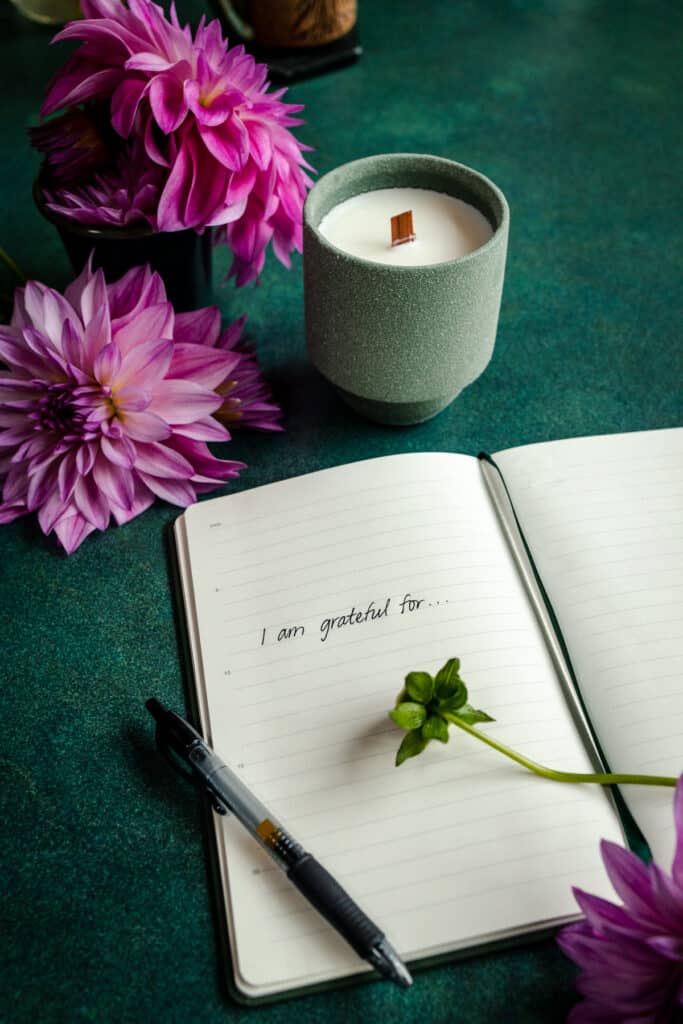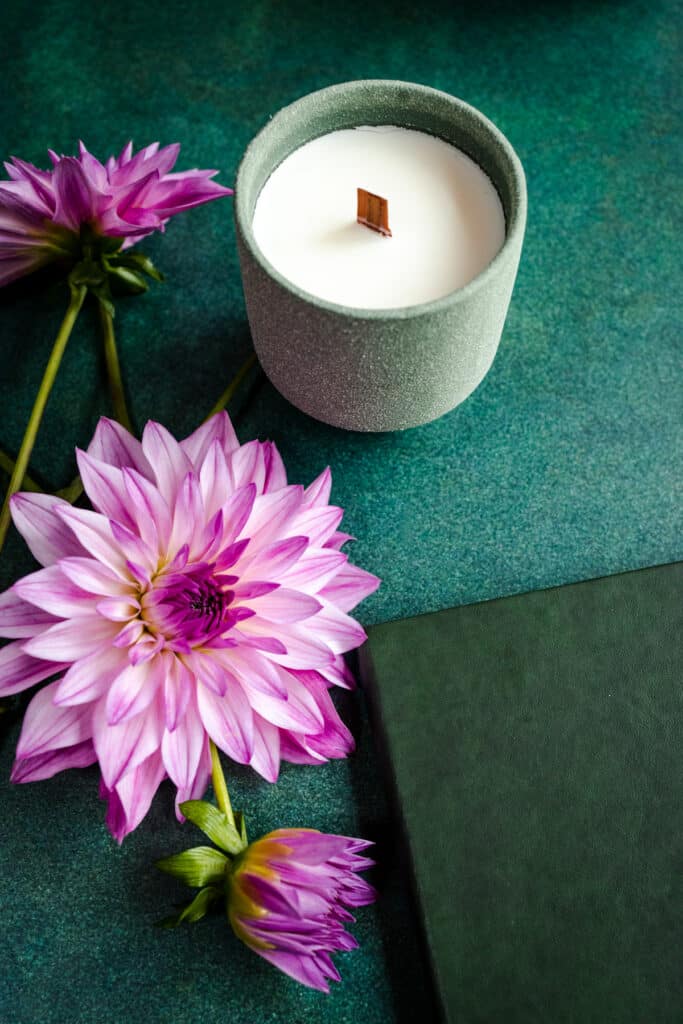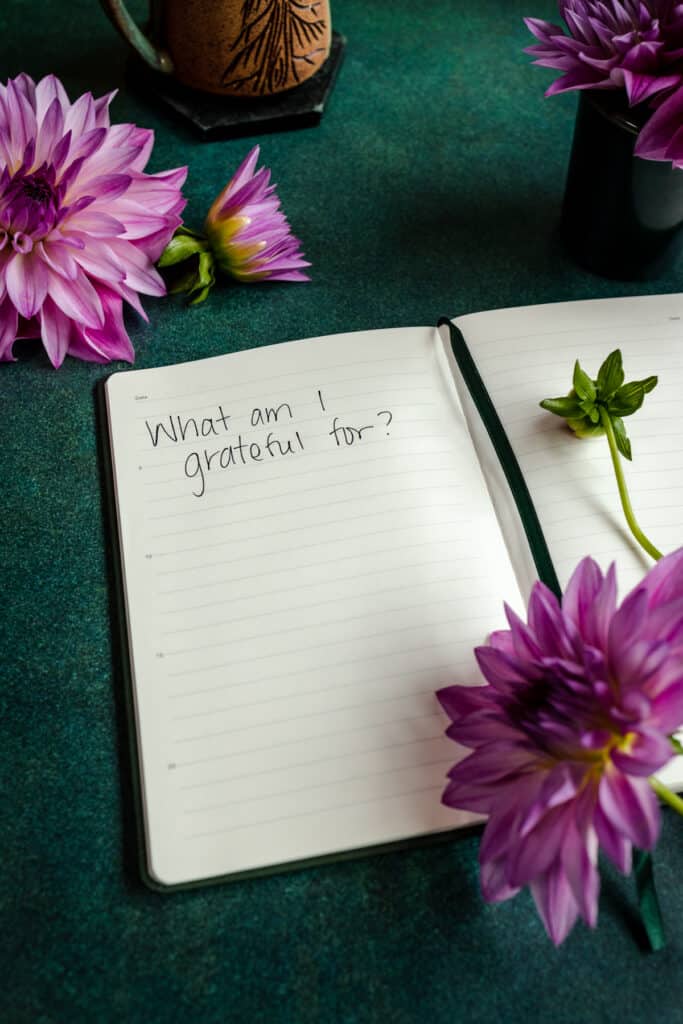In today’s fast-paced world, pausing to embrace an attitude of gratitude can become our sanctuary of happiness and mental peace. What if a simple shift in perspective could dramatically enhance your mental well-being? Let’s delve deep into the transformative power of cultivating an attitude of gratitude. Here are 21 actionable ways to nurture this positive habit. Let’s embark on this journey towards a more content and thankful life, one grateful moment at a time.
This post contains affiliate links.

What Does it Mean to Have an Attitude of Gratitude?
Having an “attitude of gratitude” means consciously adopting a mindset that focuses on being thankful and appreciative of the positive aspects of life, regardless of circumstances.
It starts with an awareness of the blessings that sprinkle our daily lives, be they material, emotional, or relational. This mindset encourages a shift in perspective, urging one to seek the positive even when faced with challenges or adversity. It doesn’t mean glossing over problems. Rather, finding elements to be grateful for within complex situations.
Engaging with gratitude as a continuous practice can reshape your outlook on life. This consistent positive focus bolsters individual mental and emotional well-being and creates a positive ripple effect on those around you. This can foster more harmonious relationships and a more optimistic community at large. In essence, an attitude of gratitude deepens our appreciation for life’s experiences, fortifying resilience and enhancing overall happiness and contentment.
To practice gratitude is to heal.
Why is Practicing Gratitude Important?
People who are grateful experience a sweeter, better version of life.
Research has shown that an attitude of gratitude toward oneself and others improves mental health. In a 2018 randomized control trial, it was found that practicing thankfulness improved one’s emotional well-being. Out of 293 participants, one group wrote letters expressing gratitude towards others. The individuals in this group showed signs of improved mental health both during the study and throughout the following months [1].
This study showed that developing an attitude of gratitude has an immediate impact on our well-being and that acts of gratitude have a ripple effect well into our future.
Sounds good, right?
Keep reading to see how you can create a practice of daily gratitude and begin living brighter.

The List: 21 Ways to Develop An Attitude of Gratitude
Embracing gratitude can transform how we perceive the world and react to challenges. Let this be your guide in fostering a more thankful perspective, enriching your life with a renewed appreciation for the daily wonders that surround you.
- Start your morning by asking yourself, “What am I Grateful For?”
First thing in the morning- I’m talking the moment you open your eyes and that brain starts firing thoughts, ask yourself, “What good things in my life am I thankful for?” This can be done verbally or in written form. You can also text it to a friend. Ideally, you’d say it out loud or write it down instead of just thinking about it in your head. You want to be able to see and feel these thoughts. - Keep a daily gratitude journal.
And do it even, or especially, on a bad day! Incorporating a gratitude practice into your daily routine will make even the worst of days seem… pretty good. Pick out a journal that makes you experience gratitude just by looking at it. Read previous entries often. We are so blessed, and often we don’t feel like it- but staring at pages upon pages of gratitude for different things is a sure way to remind you and keep the positive energy going. - Start saying, “I get to” instead of “I have to.”
This can make a huge shift in your day-to-day life.
Just think about the energy behind the phrase, “I get to,” versus “I have to.”
“I get to” makes the event, task, etc., almost exciting!
Whereas “I have to” makes it feel like a drag.
An example of this is doing laundry. It’s a task that can be boring and inconvenient, but how lucky are you to have clothes and clean water? That’s a pretty big deal- and we used to have to scrub until our hands were raw, but now we have automatic machines to wash and dry our clothes; perhaps a sunny day and nice breeze if they’re hanging out on the line? A positive outlook turns monotony into magic. - Make an effort to be completely present.
Being present is an act of gratitude. When we are fully in the present moment, we aren’t stuck wishing that we’re anywhere else. Comparison is the thief of joy! If you find yourself having negative thoughts about your current environment, take a second to make that conscious effort to shift your perspective. Immediately switch to making a gratitude list in your head. Doing this on a regular basis will reprogram your mind to see the best thing in a situation first rather than the worst.

- Text or call a friend to share gratitude with them.
This simple act can make a tidal wave of positive effects.
Goodness expands when it’s shared!
Here’s an example of a text message sharing gratitude with a friend.
“Hey Kay, I just wanted to let you know how much I appreciate you. You are such a gem in this world. You have added so much joy and love to my life. I am incredibly grateful for our friendship. Love, Rae Rae” - Do something nice for someone else.
Being of service to others makes us feel good. Certified Nurse Practitioner Amanda Logan states, “Positive gestures benefit [us] by releasing oxytocin.”* (That’s the feel-good hormone.) Giving our energy, gifts, or time to someone in need makes us happy!
This works like the butterfly effect- performing good deeds inspires others to do the same, tangibly making the world brighter.
How does a house plant act when it doesn’t receive any attention? It withers and dies. But the plant that receives the love and care it needs thrives. Be sunshine and water to others, and your own roots, as well as our whole ecosystem, will grow! - Overuse the phrase “thank you”.
How did you feel the last time you deserved a thank you but didn’t get it? Start incorporating thanks into all your daily interactions, expressing appreciation for even the smaller things- because we can all use a little thanks!

- Host a gratitude party.
Thanksgiving is rooted in pain, suffering, and injustice. Instead, hold a gratitude party! It can be any time of the year, as we can find many things to be grateful for throughout the seasons. - Take a moment of gratitude before eating.
If you aren’t great at making new habits stick, this might be the best way for you to remember to take a moment of gratitude! You have to eat- and taking just one minute each time to be thankful for the food on your plate and the good things you experienced that day is a powerful tool to nourish your body and soul. - Take a moment to appreciate nature.
There’s something about slowing down to be with Mother Earth. Take deep breaths of fresh air, listen to birdsong, and feel the wind caressing your face. Once the noise melts away, all that’s left is gratitude. Our planet gives us so much! So she should easily inspire much gratitude in you. - Meditate on gratitude.
Though there are many schools of thought and different ways to meditate, meditating on gratitude can be super simple. Take five minutes to close your eyes and be with your breath, bringing gratitude to the forefront of your thoughts. Notice the quality of this gratitude: What is its color? How does it feel? Imagine this warm thankfulness permeating your entire body until you’re fully bathed in its glow. Keep breathing deeply, envisioning it expanding to your neighbors, community, or even your whole town.
If you’d rather have more guided direction, use YouTube to find a meditation on gratitude that works best for you. Or, you can always make your own!

- Surround yourself with friends and family members who practice gratitude.
They say you’re a mixture of the five people you hang out with most. Surround yourself with grateful people who have a positive attitude, and watch as your garden of life transforms. - Before bed, reflect on your day by making a gratitude list
This practice is a great way to promote a better sense of well-being because it gives us better sleep! A study found that bedtime list-making (even a to-do list) makes us fall asleep faster.*
Other studies* have shown that having a bedtime routine, also called a wind-down routine, makes for a better sleep schedule. Taking a moment to pause and be thankful at the end of the day will lull you into sweet dreams in no time, setting up the next day for success. - Be kind to yourself when you’re sad.
The art of gratefulness means practicing it in both happy and tough times. Allow negative emotions space to be instead of judging them harshly and talking down to yourself for experiencing what we’ve deemed as a ‘bad’ feeling. Positive emotions are the same as negative ones: they’re both just feelings.
Though anger and sadness get a bad rep, they’re actually very useful for helping us make decisions. Anger is fire; it tells us what we do and don’t want. It keeps us safe by helping us remember our boundaries. Sadness is water, a beautiful, sweet emotion that reminds us we are human.
It is a blessing to be able to feel everything we do, so find ways to be grateful even when you’re feeling blue.

- Make gratitude your anchor.
Being able to return to a space of gratitude quickly will help you navigate difficult situations. Reactivity won’t come so quickly if you’re seeing a situation through the lens of gratitude because you’ll remember that the people who trigger you are really just a mirror, there to help you become a better you. You can feel thankful for the lessons rather than projecting your tension on others. When you feel triggered, try to make yourself think about the positive things in a situation. - Keep a gratitude jar.
If you aren’t a regular habit kind of person, create a special little container where you deposit especially grateful moments. You can keep it for a year, a season, or even just a week before reading. Give this practice a little time; you should see big results without much effort! - Play a game of silver linings.
This is a play on the Gratitude Jar above.
Each day, write down one Silver Lining. At the end of the week, read all of them, and see if you can remember the negative things that were happening that day. Notice how you feel about these negative events.
Are you attached to them? Do they seem comical now? Pick your favorite Silver Lining each week, and then, at the end of the month, have a competition between the weeks for your favorite Silver Lining of the entire month.
Feel the space between you and the different parts of life that we experience. Things are happening with you, not to you. You do have a say, and that say is choosing to focus on the wonderful things that daily life contains.

- Take a break from social media.
If you want more gratefulness and less depression, take a step away from your socials. Countless studies have shown the negative effects of social media on our mental health.*
We are living, breathing HUMANS, baby! We were meant to dance and create- not consume until we can’t even think for ourselves. Social Media can be a really great tool and means of connection, but without balance, it can be the fastest ticket to slipping out of a gratitude mindset. We see highlights and are tricked into believing others’ lives are better, easier, and more fun than our own- when in reality, they probably go through similar intrusive thoughts and difficult times. We’re all human, even those Instagram models on the other side of the screen.
Taking a break is always available, and it will be there when you’re ready to return. - Feel the benefits of gratitude in your physical health.
Much like the switch from “I have to” to “I get to,” incorporating gratitude into your physical life can make it a lot more enjoyable.
Instead of thinking, ”Ugh, I have to go on a run,” think, “Wow, I am so lucky to be able to move my body in this way!”
Instead of looking in the mirror and thinking, “I wish my waist were smaller,” or “I hate these wrinkles,” make the conscious choice of the thoughts: “I really love my smile,” or “My nose is so cute.”
Changing your thoughts eventually changes your reality. - Go on a gratitude walk.
Take a jaunt around your neighborhood, and don’t bring your phone. Just open your eyes and walk (or roll). See how many things you notice that make you feel gratitude for their existence. Plants, animals, smells, and sounds remind us what a blessing it is to be alive! - Write a gratitude letter.
Even better than texting a friend, write a letter to express gratitude!
Getting mail is so much more fun than seeing a little notification on a screen. It’s special to receive a letter, but writing one is also a powerful practice. Writing a letter takes paper, pen, and time. Whoever you write is guaranteed to feel a surge of gratitude themselves, sending it back to you or passing it along to someone else.

FAQ
The conscious practice of gratitude can create a positive impact on every aspect of your life. When you become seated in gratefulness, stress dissolves from the body and mind. This allows us to be more present and enjoy our experiences for all that they are.
There are so many simple things you can do that will easily bring a greater presence of gratitude into your life. Try one, or three of the examples above. By building a daily habit, we train our brains to think differently. Soon, you’ll be appreciating everything around you- rather than judging it or wishing it were different.
Practice making, “What am I grateful for?” your first thought when you wake up. Before you can get out of bed, list ten things. Start your day with a five-minute gratitude meditation, or begin with a gratitude walk each morning.
Final Thoughts on How to Develop an Attitude of Gratitude
Cultivating gratitude is more than a mere act; it’s a transformative lifestyle choice. By consciously recognizing and appreciating the multitude of blessings, both big and small, that pepper our lives, we can unlock a higher plane of mental tranquility and overall well-being.
Whether you opt for journaling, verbal affirmations, or simply taking a moment each day to reflect, incorporating some of these 21 methods can pave the way for a more joyous and contented life.
Remember, the journey to ingrained gratitude is a continuous one, but each grateful step you take enriches your life in immeasurable ways.

References
[1] Wong, Y. J., Owen, J., Gabana, N. T., Brown, J. W., McInnis, S., Toth, P., & Gilman, L. (2018). Does gratitude writing improve the mental health of psychotherapy clients? Evidence from a randomized controlled trial. Psychotherapy Research: Journal Of The Society For Psychotherapy Research, 28(2), 192–202. https://doi-org.uws.idm.oclc.org/10.1080/10503307.2016.1169332
[2] Logan, Amanda. (2022) Can expressing gratitude improve your mental, physical health? Mayo Clinic Health System. https://www.mayoclinichealthsystem.org/hometown-health/speaking-of-health/can-expressing-gratitude-improve-health
[3] Scullin MK, Krueger ML, Ballard HK, Pruett N, Bliwise DL. The effects of bedtime writing on difficulty falling asleep: A polysomnographic study comparing to-do lists and completed activity lists. J Exp Psychol Gen. 2018 Jan;147(1):139-146. doi: 10.1037/xge0000374. Epub 2017 Oct 23. PMID: 29058942; PMCID: PMC5758411.
[4} Larsen, Kristy, “Consistent Bedtime Routines are Linked to Better Sleep Outcomes: Why?” (2021). Dissertations. 1857.
https://aquila.usm.edu/dissertations/1857
[5] Braghieri, Luca; Levy, Ro’ee; Makarin, Alexey (2022) : Social Media and Mental Health, CESifo Working Paper, No. 9723, Center for Economic Studies and ifo Institute (CESifo), Munich
[6] Karim F, Oyewande AA, Abdalla LF, Chaudhry Ehsanullah R, Khan S. Social Media Use and Its Connection to Mental Health: A Systematic Review. Cureus. 2020 Jun 15;12(6):e8627. doi: 10.7759/cureus.8627. PMID: 32685296; PMCID: PMC7364393.
This post may contain affiliate links, meaning I’ll receive a commission if you purchase through those links at no extra cost to you. Please read our full disclosure for more information. Thank you for supporting Raepublic.
